Brian Libby
All images by and courtesy the author.
For the past ten months, approximately ten times a month, I have been running to the top of an inactive volcano to witness a pedestal without a statue. Over the course of these 100 runs, I’ve come to regard the pedestal’s emptiness as not just fitting but perhaps even ideal: a peaceful, ponderous dormancy after a series of eruptions.
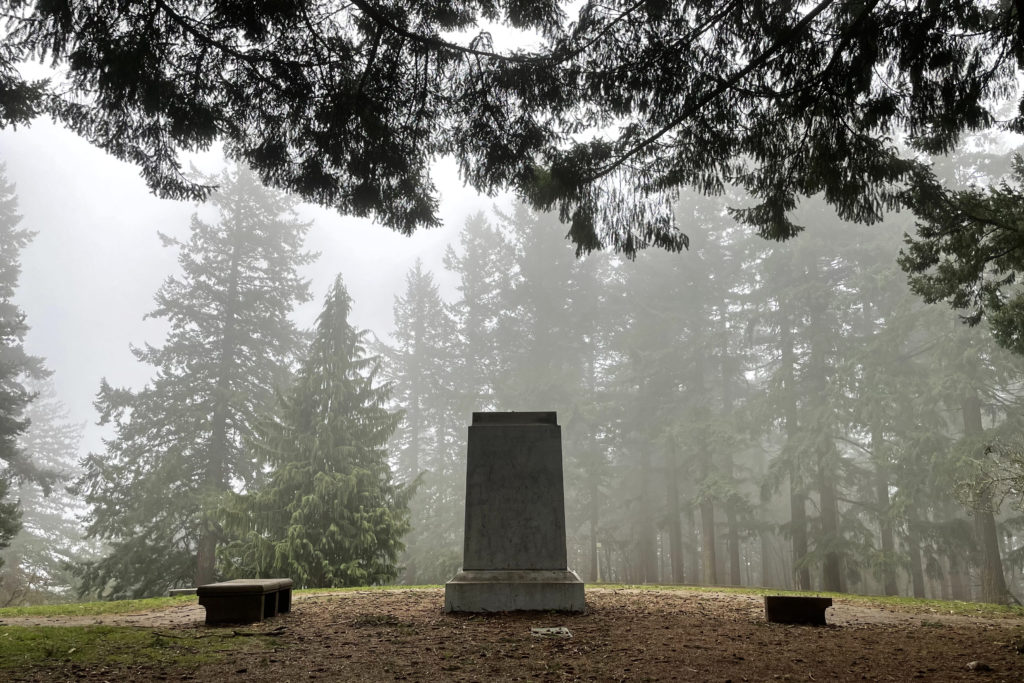
York Pedestal, 2022, digital photo.
First, in October 2020, protesters toppled the original bronze statue on this site, of late 19th and early 20th century Oregonian newspaper publisher Harvey Scott, a conservative who had tangled with his sister, women’s suffrage leader Abigail Scott Duniway. Erected in 1933, the statue had been designed by Gutzon Borglum, best known as the artist of Mt. Rushmore. The toppling came amid a wave of protests and civic unrest in the summer and fall 2020 after the killing of George Floyd by an officer of the Minneapolis (later convicted of murder). Besides the Scott statue, several others in Portland were removed by protesters, including statuary honoring former U.S. presidents Abraham Lincoln, George Washington and Theodore Roosevelt—all, coincidentally, honored at Borglum’s Rushmore. This was also part of a broader historical moment, in which statues were toppled in cities around the world, perhaps most notably those of Confederate leaders from the American Civil War.
Then, in February 2021, an anonymous artist erected on the empty Scott statue’s pedestal a bust of York, the Black slave who accompanied Meriwether Lewis and William Clark on their expedition across America from 1804-06. Though made of humble, easily-deteriorating materials, the artwork was convincingly painted to look like bronze and was popular with the public, who hiked to the top of Mt. Tabor in large numbers. The York bust even found favor with City of Portland leaders, who contemplated commissioning a permanent version of the piece. Though York had lived over 200 years earlier, his celebration as a historic figure also felt like a fittingly positive gesture, connecting Black Lives Matter to America’s longer history of racial injustice. Yet just five months after it unexpectedly arrived, in July 2021 the York statue too was vandalized and toppled by another activist, this time a Donald Trump supporter caught in the act on camera.
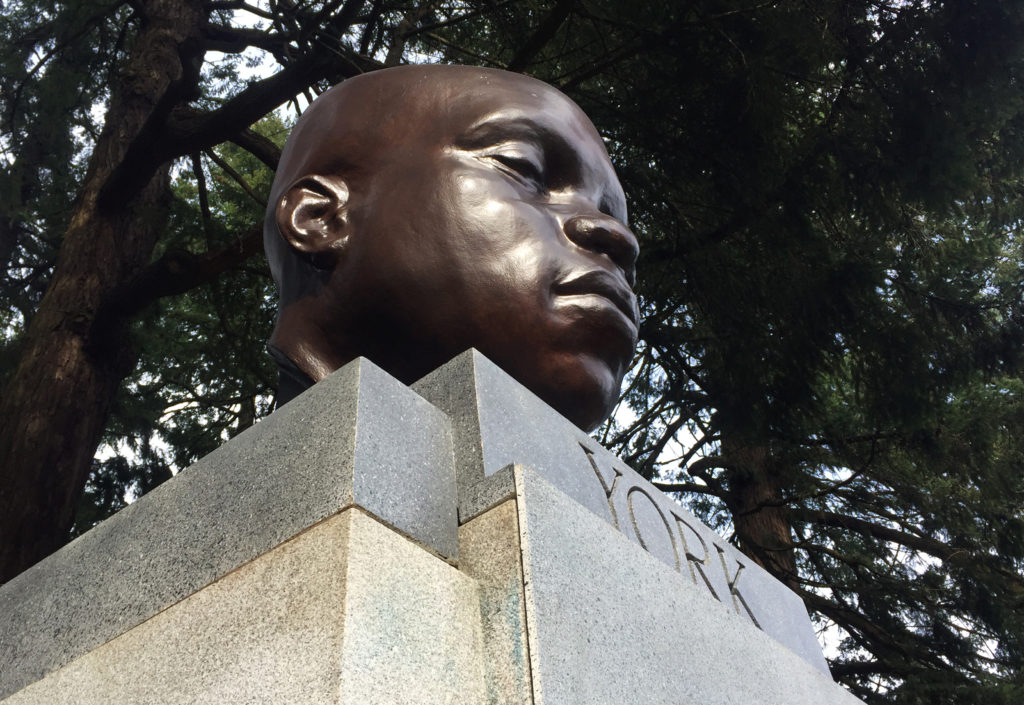
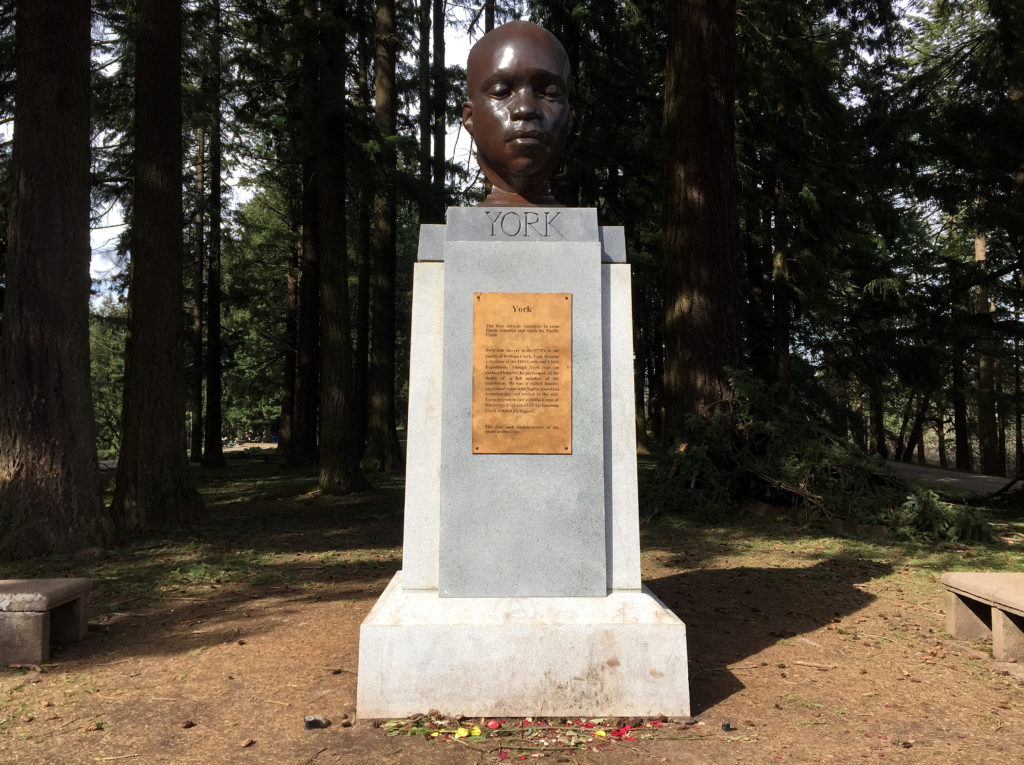
York Bust, 2021, digital photo.
By coincidence, I happened to purchase a house near Mt. Tabor in September, just a few weeks after the York statue’s toppling. I’m an enthusiastic runner, and soon the park became my regular destination, its hundreds of trees providing shade in warm months and its 176 acres offering respite from the clamor of city life. Passing the empty pedestal two to three times a week, I expected the City of Portland to take some kind of action. Instead, it’s remained as-is, for a year and counting. That inaction, I’ve come to realize, has been the smartest move leaders could make.
Maybe the real answer isn’t whom should be honored in bronze likeness here, but whether there should be a statue at all. Yet the pedestal perhaps has subtle value as art in its own right: a testament to our times that, unlike the purely representational imagery of a human likeness in bronze, allows for interpretation.
First acquired by the City of Portland in 1909, Mt. Tabor is a volcanic cinder cone, part of what’s known as the Boring Lava Field, covering an area of about 1,500 square miles of the northern Willamette Valley between Portland and Mt. Hood. Rising to 636 feet, Mt. Tabor is taller than any Portland building, and there’s a postcard view of downtown from its top, a few feet away from the pedestal. My favorite kind of Tabor-top moment, though, isn’t clear sunny days but when the mountain becomes enveloped in fog, creating an ethereal, almost dreamlike atmosphere—the only weather that inspires me to pause my run, look around and rejoice.
Portland’s Mt. Tabor Park was named after Mount Tabor in Israel, where according to the Bible, the Transfiguration of Jesus occurred. In this moment of metamorphosis, after coming to the mountaintop to pray with his disciples, Jesus began to glow with light. The Old testament figures of Moses and Elijah appear by Jesus’s side, and he is called “Son” by the voice of god. Many Christian traditions commemorate the event in the Feast of the Transfiguration, held in early August.
It’s as if the name of Portland’s Mt. Tabor—a name associated for two thousand years with transformation—prefigures the tumult over these Harvey Scott and York artworks, or perhaps the ongoing aftermath.
Mt. Tabor Park was given its name by Plympton Kelly, whose father, Episcopal minister Clinton Kelly, had come to the Oregon Country in 1847, four years before Portland’s incorporation as a city. Its naming was a testament to Clinton’s evangelism, as well as an indication that Oregon was God’s country. Thousands of families had risked their lives to come here during the Great Migration, lured by the Willamette Valley’s fertile farmland, described as a second Eden, and by the Donation Land Claim Act of 1850, which offered land free to white settlers. Yet injustice accompanied opportunity from the start. When Oregon became a U.S. state in 1859, twelve years after Clinton Kelly’s arrival, it was the first with Black exclusion laws on its books.
Because Mt. Tabor was too steep to be converted to farm land, it was given over to the city, first as the site of two open reservoirs completed in 1894 (to which additional reservoirs above and below ground have been added). But by the turn of the 20th century, Portland’s burgeoning population east of the Willamette River (downtown occupies the west side)—part of its so-called streetcar suburbs—began to need park space. After all, this was a time of the City Beautiful movement, when the developing industrial age swelled American cities and caused a reciprocal need for some of the first ambitious city parks and park plans.
In 1903, with plans underway for the ambitious 1905 Lewis & Clark Centennial Exposition, a world’s fair that would transform Portland from small town to the Pacific Northwest’s largest city over the ensuing decades, the city commissioned America’s most prestigious landscape architecture firm to create a master park plan. The sons of Frederick Law Olmsted, the famed designer of New York’s Central Park, had after their father’s death grown the family firm into a nationwide presence. John C. Olmsted’s Portland master plan led to some of the city’s most important greenspaces, including Forest Park, the largest urban wilderness in the United States; and though it took another eight decades, Tom McCall Waterfront Park along the Willamette River downtown, was first recommended by Olmsted. Unfortunately, the recommendation to set aside Ross Island, a forested enclave now decimated by sand and gravel mining, was not heeded. But the setting aside of Mt. Tabor and several other cinder cones in the greater Portland area was. In 1909, the City of Portland used voter-approved bonds to purchase approximately forty lots on Mt. Tabor for $366,000.
Mt. Tabor Park was even designed by an Olmsted disciple and former employee of the firm: Emanuel Tillman Mische, who had been hired as Portland’s parks superintendent at the Olmsted brothers’ suggestion. Mische’s design took advantage of Mt. Tabor’s natural topography, creating a series of undulating pathways and framed views showcasing native plants and trees. Tabor’s own volcanic cinders were even utilized in surfacing the park’s roads. Today, it’s possible to feel immersed in nature at Mt. Tabor, almost completely leaving behind the clatter and clamor cars of the city outside. And it’s a park for everyone; the Olmsteds, particularly Frederick the patriarch, who had first gained fame as an abolitionist writer and as co-founder of The Nation magazine, saw city parks as organs of democracy.
One aspect of Mt. Tabor Park not included in Mische’s original design, nor original to any of the Olmsted’s parks scattered across America, was statuary. Though they have become a common presence in these parks, statues were added decades after the Olmsteds’ designs themselves. The Harvey Scott statue was erected 24 years after the park’s dedication.
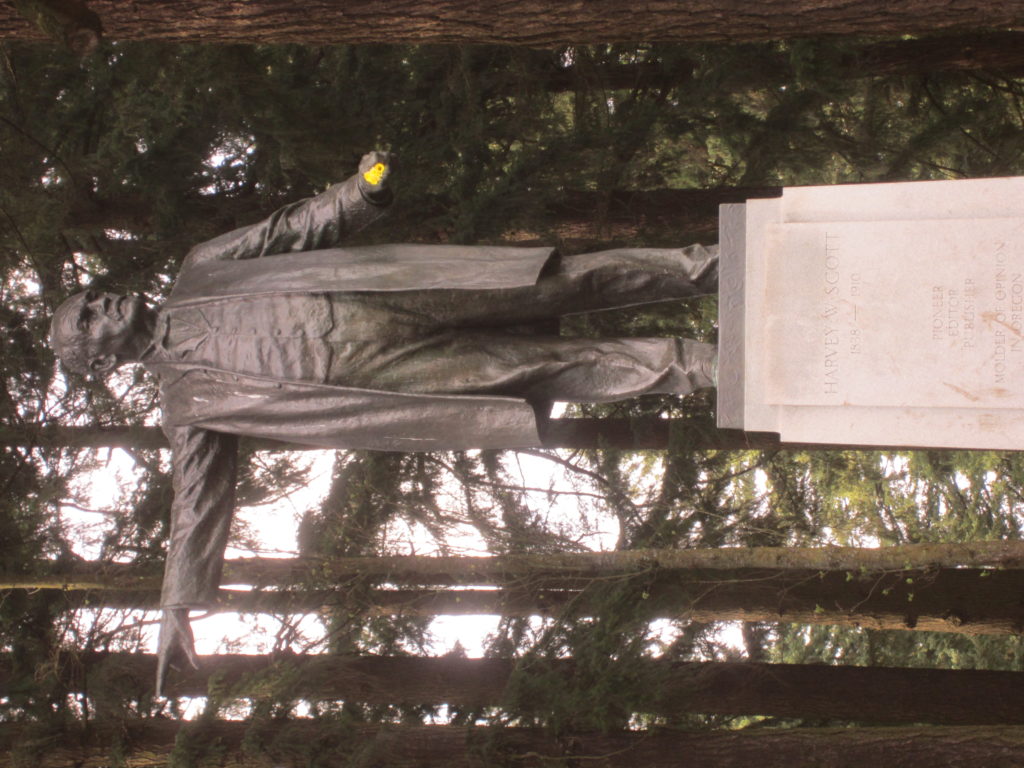
Mount Tabor Park, 2012, digital photo. Image from Wikimedia Commons.
Ascending Mt. Tabor Park in years past, the Scott statue’s setting seems slightly absurd—an act of heroic bronze hagiography dwarfed by the true statues that surround it: soaring Douglas fir trees. Even though the statue was handsomely rendered by the artist of America’s most famous historical monument, its scale could never compete with 300-foot conifers numbering in the hundreds. I’m almost surprised bronze Harvey hadn’t become naturally covered in moss. Yet perhaps paradoxically, the pedestal arguably possesses an artistic presence neither the Scott nor the York artworks ever did.
What the past ten months of running past the empty pedestal has taught me is that the two acts of statue-toppling violence and the clandestine act of creativity in between (the York statue) were brief moments in time. The longer the pedestal stands there, the better it can tell the story, and multiple stories. It’s a monument to our own ambitions and folly, but one arrived at by accident. Ultimately, the empty pedestal is a kind of blank canvas: onto which we project our own ideas. We couldn’t have planned it, because its power derives partly from the vandalizing acts that made the pedestal a solo presence: a reminder of unrest.
Yet a greater power comes from the forest itself: able to swallow both statues and their pedestals. Especially given that only massive reforestation across the globe will save us from catastrophic climate change, the forest makes the most sense of all as the monument. After all, transfiguration like that associated with the biblical Mount Tabor isn’t simply a synonym for transformation. Rather it’s a specific, special type of transformation, into something more beautiful and spiritually compelling: something radiant.
Maybe what this episode teaches us is that to render humans in bronze is to make them less human: to reduce them to one-dimensional figures and one-note stories—to mere symbols—when the reality is messier and more complex, yet also more compelling. In a sense, neither Harvey Scott or even York nor their likenesses in bronze or plastic can reach true radiance. Only the place itself can.
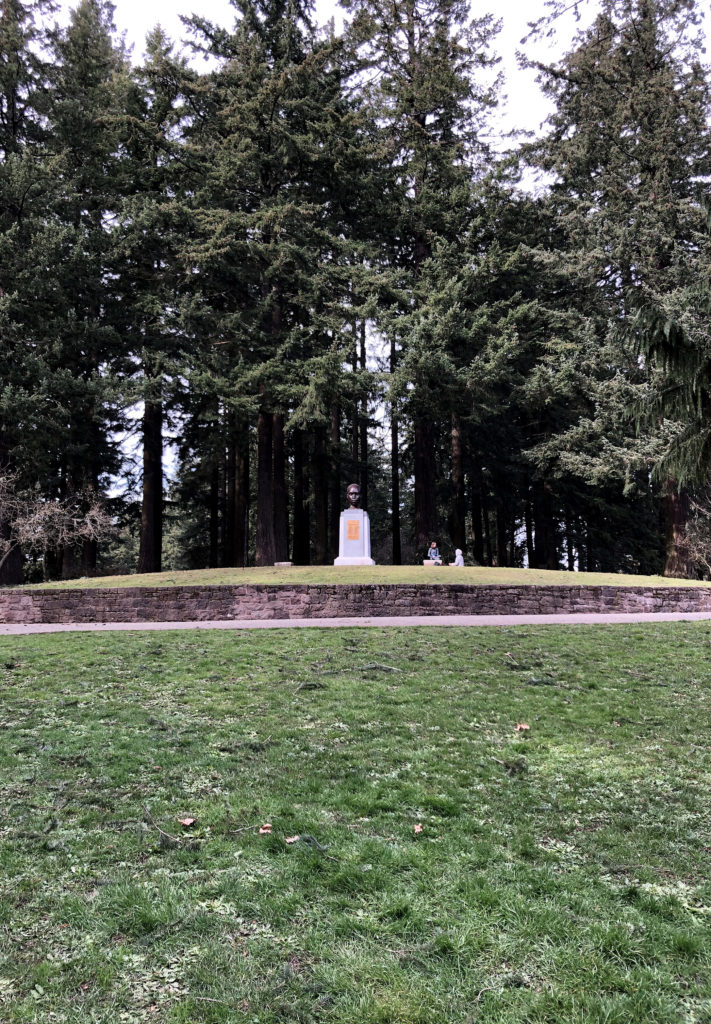
York Bust, 2021, digital photo.
After those hundred runs to the top of Mt. Tabor and counting, I’m here to tell you that there is indeed a special energy there. Whether one calls it spiritual or secular is a personal decision. The important thing is not the statues we encounter, nor even the empty pedestal. It’s that we can be transformed by our time there.
Brian Libby is a Portland-based architecture and arts journalist, photographer and filmmaker. His writing has appeared in nine sections of The New York Times, and has also been published in The Wall Street Journal, The Atlantic, Citylab, The Oregonian, Metropolis and Dwell, among many others.